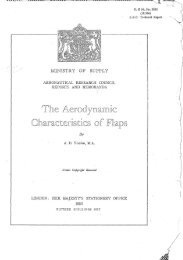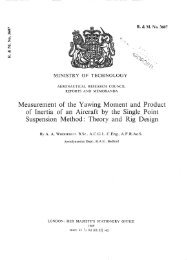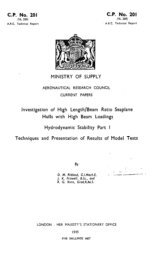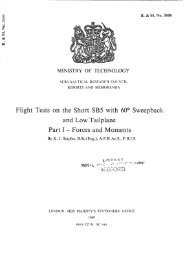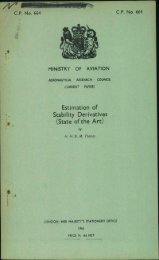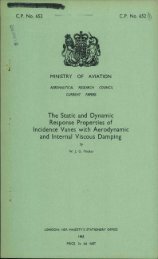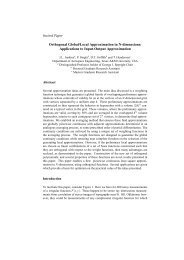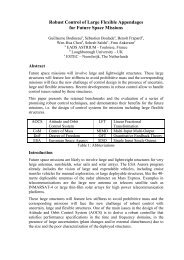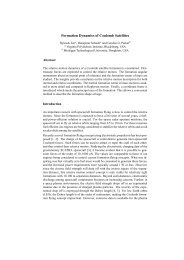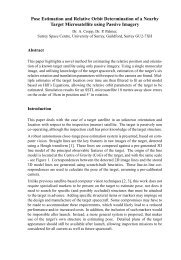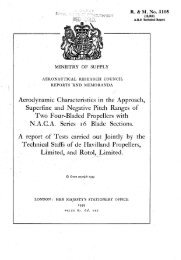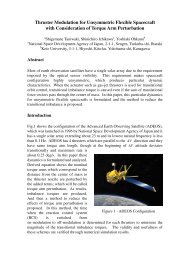The Prediction of Helicopter Rotor Hover Performance using a ...
The Prediction of Helicopter Rotor Hover Performance using a ...
The Prediction of Helicopter Rotor Hover Performance using a ...
You also want an ePaper? Increase the reach of your titles
YUMPU automatically turns print PDFs into web optimized ePapers that Google loves.
<strong>The</strong> source <strong>of</strong> the two-dimensional aer<strong>of</strong>oil data required by the performance<br />
calculation is important especially when the advantages <strong>of</strong> changing to a new<br />
aer<strong>of</strong>oil section for the blades is being investigated. <strong>The</strong> experimental data<br />
for the different aer<strong>of</strong>oils should ideally be obtained from tests in the same<br />
wind tunnel with the same amount <strong>of</strong> transition fixing on the aer<strong>of</strong>oil. <strong>The</strong><br />
aer<strong>of</strong>oil data sometimes needs to be corrected as there can be some difference<br />
in the aerodynamic performance <strong>of</strong> the smooth aer<strong>of</strong>oil surface tested and the<br />
actual rotor blade which may be fitted with anti-erosion and de-icing strips or<br />
trailing edge tabs<br />
<strong>The</strong> usual method <strong>of</strong> testing a two-dimensional aer<strong>of</strong>oil in the UK is in a<br />
transonic wind tunnel with slotted or perforated walls, and with transition fixed<br />
to ensure that the boundary layer on the aer<strong>of</strong>oil is turbulent before the shock<br />
wave. <strong>The</strong> aer<strong>of</strong>oil drag coefficient is normally measured by a wake traverse.<br />
Results from wind tunnel tests made in the USA have <strong>of</strong>ten shown unrealistically<br />
low drag coefficients at low angles <strong>of</strong> attack because transition has not been<br />
fixed. Other results obtained by strain gauging a floating section <strong>of</strong> the aero<br />
foil can also be unreliable because <strong>of</strong> poor sealing around the slots <strong>of</strong> the<br />
measuring station. <strong>The</strong> source <strong>of</strong> the aer<strong>of</strong>oil data used in the calculations is<br />
quoted for each example, and the details <strong>of</strong> the rotor geometry are also given as<br />
these have not always been easy to obtain.<br />
3. 1 Two bladed model rotor<br />
<strong>The</strong> experimental data for the two bladed model rotor was obtained by<br />
Landgrebe during the tests to derive the generalised wake geometry. <strong>The</strong> rotor<br />
chosen had blades with an eight degree linear twist and a chord length <strong>of</strong><br />
49.8 mm giving a solidity ratio <strong>of</strong> 0.0466, and a blade aspect ratio <strong>of</strong> 13.6.<br />
<strong>The</strong> tip speed was 213 m/s corresponding to a rotor rotational speed <strong>of</strong> 3000 rpm.<br />
<strong>The</strong> other geometric details <strong>of</strong> the rotor are given in section 2.3.<br />
<strong>The</strong> two-dimensional aer<strong>of</strong>oil data for the NACA 0012 aer<strong>of</strong>oil used in the<br />
calculations has also been taken from Ref.5 (Fig.90), and are based on measured<br />
low Reynolds number data which has been synthesised to provide a correlation<br />
between the test results for the untwisted, two bladed model rotor and the<br />
results predicted by blade element-momentum theory. <strong>The</strong> resulting data has a<br />
high value <strong>of</strong> lift curve slope and are rather sparse. <strong>The</strong> variation <strong>of</strong> lift<br />
coefficient with angle <strong>of</strong> attack is shown for only three Mach numbers and the<br />
data required in the tip region, where the Mach number is about 0.6, falls<br />
17



